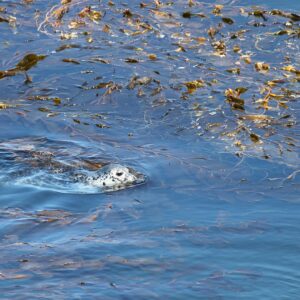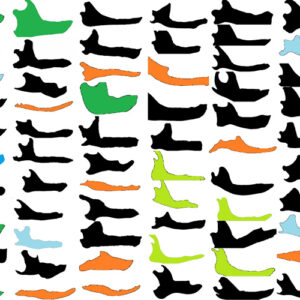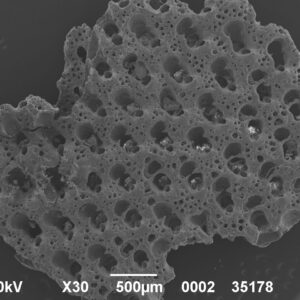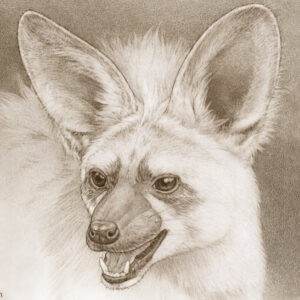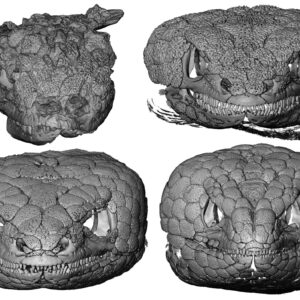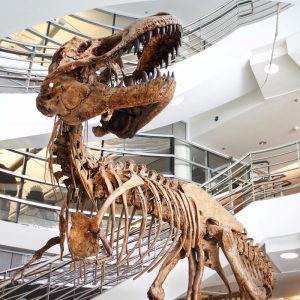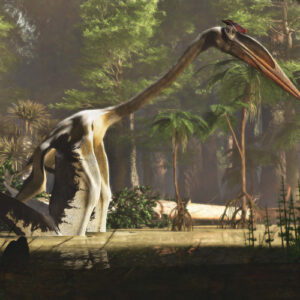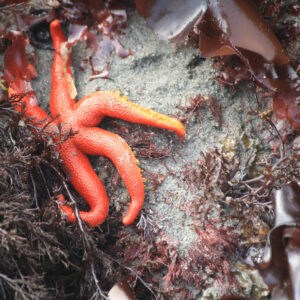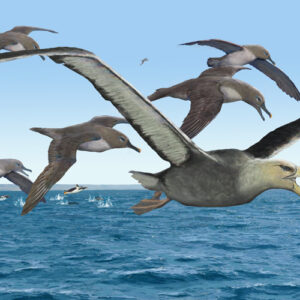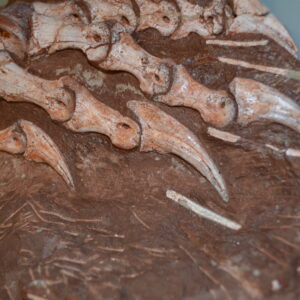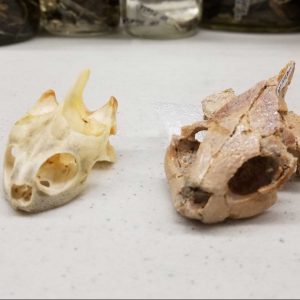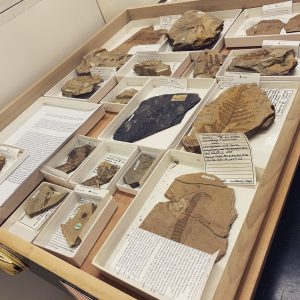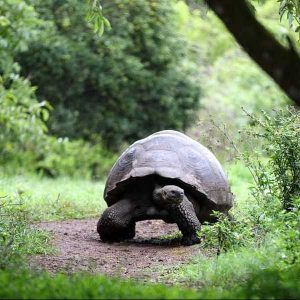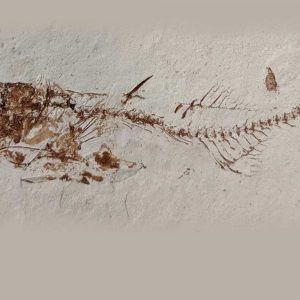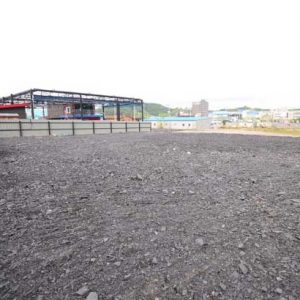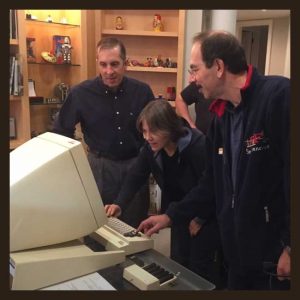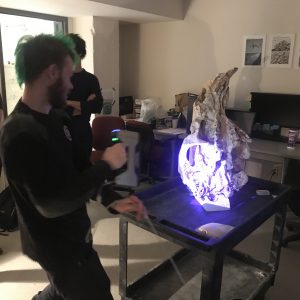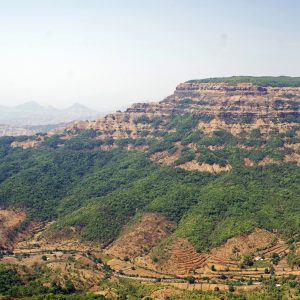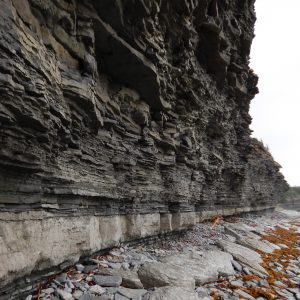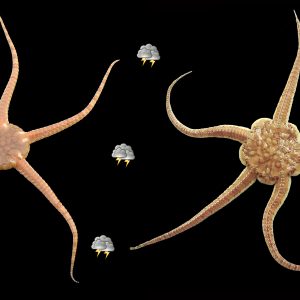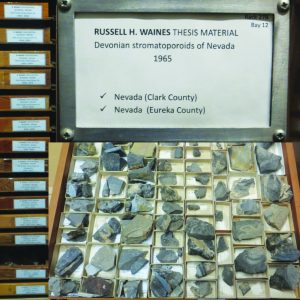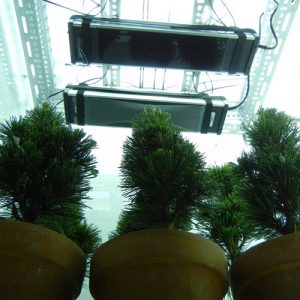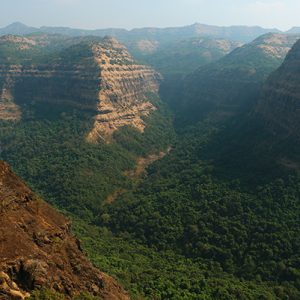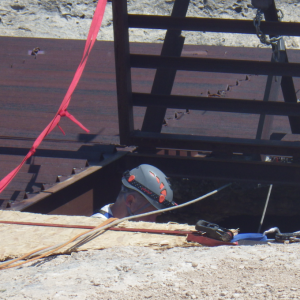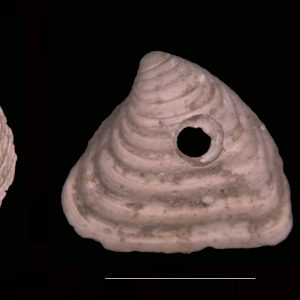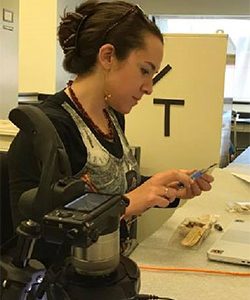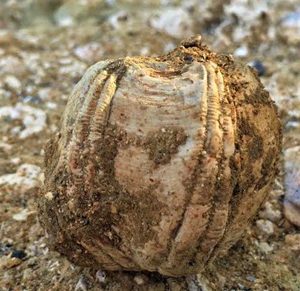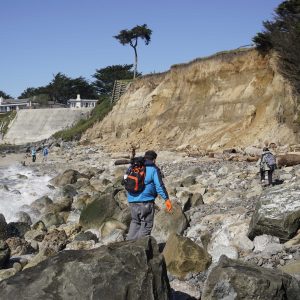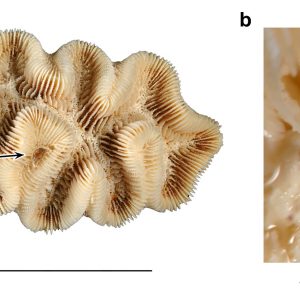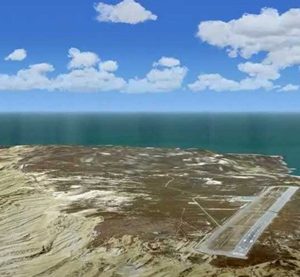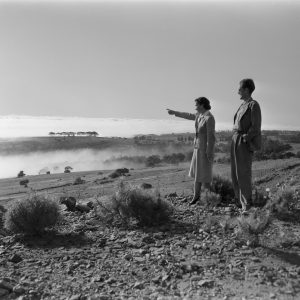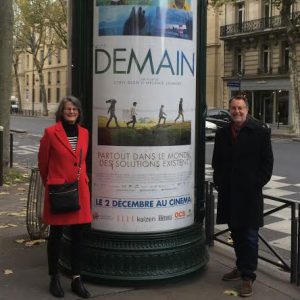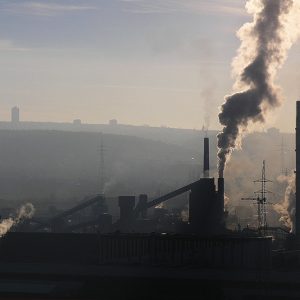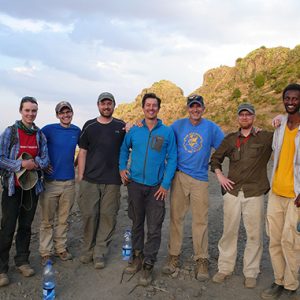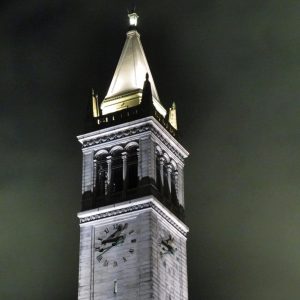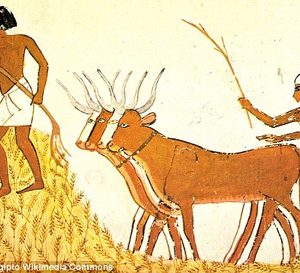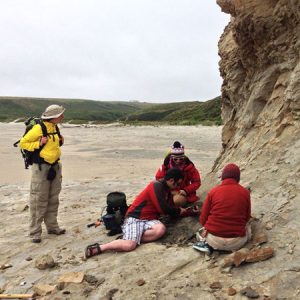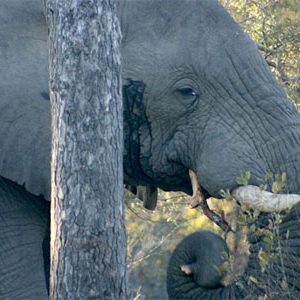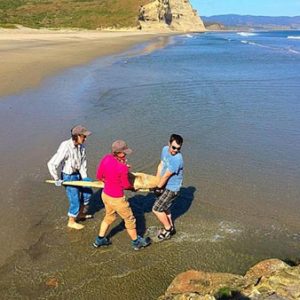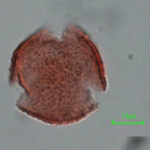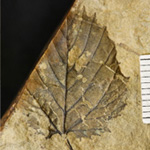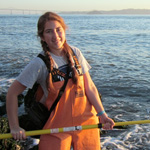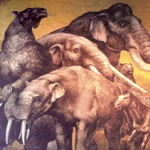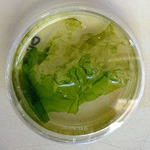The New Year ushers in a trio of publications from members of the UCMP community: Graduate student Jaemin Lee and collaborator Nick Famoso published on the oldest (29-million-year-old!) fossil grasshopper nest. Find the paper published on eScholarship. Professor Cindy Looy, collaborator Steffan Kiel and UCMP alum Rosemary Romero published a study on the age of fossil kelp holdfasts and the marine communities built upon them. Read more about it from this UC … [Read more...] about Grasshoppers, kelp, and frogs featured in recent publications from UCMP
A jaw-dropping conundrum: Why do mammals have a stiff lower jaw?
From the 20-foot-long jawbones of the filter-feeding blue whale to the short, but bone-crushing, jaws of the hyena and the delicate chin bones of a human, the pair of lower jawbones characteristic of mammals have evolved with amazing variation. But at first glance, having a single bone on each side of the head — which creates a stiff lower jaw, or mandible — doesn’t appear to give mammals an advantage over other vertebrates, which have at least two and as many as 11 bones comprising each side … [Read more...] about A jaw-dropping conundrum: Why do mammals have a stiff lower jaw?
Life cycles: bringing new questions to old collections
Frankfurt, Germany is a museum town. Along the south side of the aptly named Main River are museums of Renaissance art, iconography, sculpture, design, and film. Each of the old waterfront mansions is home to treasures that spill out through their gardens and into the street, where today’s working artists sell pieces of equal beauty in the public market. It seems required that every footbridge across the river has a café and an accordion player at either end. North of the river is modern art, … [Read more...] about Life cycles: bringing new questions to old collections
Was this hyena a distant ancestor of today’s termite-eating aardwolf?
Curator and Assistant Professor Jack Tseng is co-author on a Vertebrata Palasiatica article describing a new genus and species of a small-bodied hyena from the Miocene of Gansu Province, China. The unique features identified in 12-14 million year fossil skulls shed new light on the ancestral history of modern termite-eating hyenas. Read more in Berkeley News. … [Read more...] about Was this hyena a distant ancestor of today’s termite-eating aardwolf?
First fossil of iconic alligator lizard is way out of range!
Alligator lizards of the genus Abronia are currently found in montane cloud forests and seasonally dry forests of Mexico and Central America. These physically striking and colorful lizards are popular among both scientists and the public and are increasingly recognized as conservation flagship taxa. A recent study by MVZ postdoctoral fellow and UCMP affiliate Simon Scarpetta and coauthor David Ledesma describes the first fossil and only recognized extinct species of Abronia. The fossil was … [Read more...] about First fossil of iconic alligator lizard is way out of range!
T. rex’s short arms may have lowered risk of bites during feeding frenzies
A recent paper by Curator and Professor Emeritus Kevin Padian in the journal Acta Palaeontologia Polonica, promotes a new hypothesis for T. rex’s short arm length. Follow his integrative approach to the often-asked question on T. rex arms that considers social organization, feeding behavior, and ecological factors as outlined in an article in Berkeley News. … [Read more...] about T. rex’s short arms may have lowered risk of bites during feeding frenzies
New Memoir on Quetzalcoatlus from Kevin Padian, Professor Emeritus
Kevin Padian, Curator Emeritus, co-edited a new Society of Vertebrate Paleontology Memoir on the Late Cretaceous pterosaur Quetzalcoatlus. The eight articles in the Memoir shed new light on bones collected from Big Bend National Park in the 1970’s by Douglas Lawson who would later obtain his PhD at Berkeley. The SVP Memoir is highlighted in Berkeley News. Data and interpretations from scientists and illustrations from artists provide fascinating information on pterosaur anatomy, movement, and … [Read more...] about New Memoir on Quetzalcoatlus from Kevin Padian, Professor Emeritus
Forty phyla in forty days
Marine invertebrate zoology in Friday Harbor, Washington Paleontologists speak of Friday Harbor Labs in the nostalgic tones reserved for only the best field stations. As I hopped off my ferry to the San Juan Islands, carried my duffel bag through the namesake harbor town, and stepped at last under the campus’ old-growth cedars, it was clear why. I came to take FHL’s flagship summer course, Marine Invertebrate Zoology, which surveys forty phyla in as many days. In the mornings, we … [Read more...] about Forty phyla in forty days
Antarctica yields oldest fossils of giant birds with 21-foot wingspans
Fossils recovered from Antarctica in the 1980s represent the oldest giant members of an extinct group of birds that patrolled the southern oceans with wingspans of up to 21 feet that would dwarf the 11½-foot wingspan of today’s largest bird, the wandering albatross. Called pelagornithids, the birds filled a niche much like that of today’s albatrosses and traveled widely over Earth’s oceans for at least 60 million years. Though a much smaller pelagornithid fossil dates from 62 million years … [Read more...] about Antarctica yields oldest fossils of giant birds with 21-foot wingspans
Best laid plans: a new fossil of a dinosaur mother full of eggs and information
Birds and bird eggs are familiar stuff: we see them daily in our backyards and even in our kitchens. But ask the classic questions: where did egg laying come from and how did it get that way? Answers are hard to come by. A gravid theropod dinosaur discovered with fossilized eggs still inside it helps explain how birds evolved their distinctive ways of reproducing. Described in a paper in the Journal of Vertebrate Paleontology by recent UCMP alumnus Ashley Poust and co-authors from China and … [Read more...] about Best laid plans: a new fossil of a dinosaur mother full of eggs and information
The tortoise and the hare: the varied pace of research
Confinement at home due to the Covid-19 pandemic has provided an opportunity to reflect on the pace of my research over the last year. Thinking back to Aesop’s fable of the Tortoise and the Hare, I see that my research has adopted traits from both animals: sometimes moving slow and steady, while other times travelling at break-neck speed. Despite this variability in research pace, the UCMP has been a constant presence during my research through its supportive staff and generous financial … [Read more...] about The tortoise and the hare: the varied pace of research
Back to the Devonian for the Pteridophyte Collection Consortium (PCC) project
During the summer of 2019 we (graduate students Mackenzie Kirchner-Smith and Ixchel Gonzalez-Ramirez) spent a month working in the Paleobotanical Collections of the National Museum of Natural History (NMNH) in DC as part of the NSF-sponsored Pteridophyte Collection Consortium project (PCC). This project, led by PIs Carl Rothfels, Diane Erwin and Cindy Looy, seeks to digitize more than 1.7 million modern and fossil pteridophyte specimens. During the month at the NMNH we digitized more than 700 … [Read more...] about Back to the Devonian for the Pteridophyte Collection Consortium (PCC) project
Will turtles survive climate change?
What future for turtles? Our best guide to the future is the study of a group's past. Senior Museum Scientist Patricia Holroyd, in collaboration with United Kingdom scientists led by Terri Cleary, present a comprehensive new study in the journal Palaeontology detailing the origin and spread of turtles for the first 250 million years of their evolution. Read more about the work at the Natural History Museum website. … [Read more...] about Will turtles survive climate change?
Fossil fishing for clues about a prehistoric invasion
The school year has ended, but with the ongoing pandemic pushing most usual summertime activities off the table, my thoughts have been turning to how I spent my last summer: organizing fishing trips to Nevada. These excursions weren’t exactly spent relaxing on a boat in Tahoe reeling in trout. Rather, my companions and I were kneeling in a defunct quarry under the desert sun, prying apart layers of blindingly white rock in search of the fossils of small fish that once lived in a long-disappeared … [Read more...] about Fossil fishing for clues about a prehistoric invasion
South Korea’s rich Cretaceous history: A window into the past
Unique and rare deposits in South Korea provide a glimpse of Cretaceous flowering plant ecosystems It has been over a month since the closure of the UC Berkeley campus and the UCMP due to the ongoing pandemic. During the shelter-in-place, I have been fortunate enough to be able to continue research from home. Many images of fossils that I am working on at the moment are from a summer 2019 research trip to South Korea. Thanks to the research award I received from UCMP, I was able to do fieldwork … [Read more...] about South Korea’s rich Cretaceous history: A window into the past
Reading Between the Rocks: The Return to Anticosti
Having the opportunity to return to a field site is, in many ways, like rewatching a favorite movie series. On your first pass through, everything is unexpected and unfamiliar. For some movies, the amount of information and detail can be overwhelming. On your second pass through, even though you now know the characters, the setting, and the plot, you begin to notice important details that you missed the first time. Each time you rewatch the series, you discover new things and form new ideas, and … [Read more...] about Reading Between the Rocks: The Return to Anticosti
Paleontologic Data Fossilized on IBM 8” Floppies
The Pennsylvanian (323-299 million years ago) is one of the most interesting time periods in Earth’s history. Giant dragonfly relatives like Meganeura (>2 ft wingspan!), 8-ft-long millipedes named Arthropleura, and early mammal-like reptiles lived in a world that likely had atmospheric oxygen levels well above today’s. These animals roamed a landscape dominated by extensive peat swamps, covering large parts of what was then Euramerica. These swamp forests would look entirely … [Read more...] about Paleontologic Data Fossilized on IBM 8” Floppies
New tiny 44 million year old bird fossil links Africa and Asia to Utah
NEWS RELEASE A new species of quail-sized fossil bird from 44 million year old sediments in Utah fills in a gap in the fossil record of the early extinct relatives of chickens and turkeys, and it shows strong links with other extinct species from Namibia in Southern Africa and Uzbekistan in Central Asia. In their paper in the online scientific journal Diversity, the authors Dr. Thomas Stidham (Institute of Vertebrate Paleontology and Paleoanthropology, Chinese Academy of … [Read more...] about New tiny 44 million year old bird fossil links Africa and Asia to Utah
Fossil Feature: Multituberculates
The UCMP has one of the best collections of multituberculates, a small mammal from the Cretaceous characterized by their very interesting and very bumpy teeth. Luke Weaver, a PhD candidate from the Wilson Lab at the University of Washington visited the museum in Summer of 2018 to check out the collection and further his own research into these interesting creatures. His visit was supported in part by the Doris O. and Samuel P. Welles Research Fund. Check out the video for more on these … [Read more...] about Fossil Feature: Multituberculates
Researchers from Down Under come to UCMP to study our Australian fossils
Kangaroos … in Berkeley? That’s right, mate. You won’t find them leaping around the campus, though. Because they’re in the Museum of Paleontology’s fossil collections. In the 1950s, then-curator and professor Ruben A. Stirton decided to go to Australia’s Tirari Desert to look for fossil marsupials. He wanted to find evidence to answer the question of the origin and spread of marsupials through space and time. Did they come from Australia, Antarctica, or … [Read more...] about Researchers from Down Under come to UCMP to study our Australian fossils
Asteroids or volcanoes?
UC Berkeley alumnus Courtney Sprain and Berkeley Geochronology Center Director Paul Renne are lead authors on a report in Science detailing new argon-argon dating of the Deccan Traps in India. Their work on the timing of the Cretaceous-Paleogene extinctions relative to the Chicxulub impact and Deccan flood basalt eruptions remains the subject of exciting, ongoing research. Read more in the Berkeley News Center … [Read more...] about Asteroids or volcanoes?
Reading between the rocks: Reinterpreting the Late Ordovician mass extinction
This past summer, I had the opportunity to conduct my first field season on Anticosti Island (Québec, Canada). Located in the subarctic of Canada, Anticosti Island preserves a 200 kilometer-long transect of ancient seafloor. Late Ordovician tropical reefs and fossils are beautifully preserved across the island in towering coastal cliffs and river canyons. The sheer size of the island is astounding, and the insight its fossil record could provide into early Paleozoic marine communities is … [Read more...] about Reading between the rocks: Reinterpreting the Late Ordovician mass extinction
How often does extreme competition occur between species on the ocean floor?
Look around in nature or even in the city and you will see that organisms are not static entities, but interact with one another. Think of a robin with a worm in its beak, a tick crawling on your leg looking for a spot to puncture your skin, or two bucks fighting during the rutting season for the right to mate. The sea floor is also a place where animals search or fight for food to stay alive. On the continents, food is not unlimited; every individual tries to collect a piece of the pie (Fig. … [Read more...] about How often does extreme competition occur between species on the ocean floor?
Russell Waines’ stromatoporoid collection
Russell H. Waines was a geologist who dedicated most of his life to ancient sponges, the stromatoporoids, which were one of the most important reef builders during the Paleozoic. When I was a graduate student researcher at the UCMP in 2013, I had the pleasure of organizing this collection (Figure 1), which includes approximately 2000 fossil specimens (566 of which are registered in the UCMP database) mainly from the Devonian of Nevada, but also from Alaska, Arizona, California, New York, Utah, … [Read more...] about Russell Waines’ stromatoporoid collection
UCMP paleobiologists shed new light on ozone shield failure, forest sterility, and mass extinction
Members of the Looy Lab - Jeff Benca, Ivo Duijnstee, and Cindy Looy - co-authored a paper in the journal Science Advances. It details exciting new findings from experimental research on the effects on UV-B induced stresses on forest decline during the end-Permian extinction. Read more in the University press release. View the video: https://youtu.be/bz9je0Me4AU … [Read more...] about UCMP paleobiologists shed new light on ozone shield failure, forest sterility, and mass extinction
A new destination for disaster enthusiasts
The Cretaceous-Paleogene (K-Pg or K-T) mass extinction — the event in which the non-avian dinosaurs, along with about 70% of all species in the fossil record went extinct — was probably caused by the Chicxulub meteor impact in Yucatán, México. However, scientists have long wondered about the massive volcanic eruptions that were occurring in northwestern India at about the same time, the Deccan Traps. Volcanism is the likely cause of several prior mass extinctions, with no convincing evidence for … [Read more...] about A new destination for disaster enthusiasts
A Pleistocene pit-stop: the Barnosky lab excavates Natural Trap Cave, Wyoming
You might think that an 85-foot-deep hole where a bunch of horses, wolves, camels, elephants, and plenty of other animals accidentally plummeted to their death over tens of thousands of years would have enough red flags to make going into it yourself sound like a bad idea. But what if these unfortunate critters could tell you what their life was like and how they died? What if they could give you a warning about their death in a warming world after the last ice age and what it means for life in … [Read more...] about A Pleistocene pit-stop: the Barnosky lab excavates Natural Trap Cave, Wyoming
What do traces of predators tell about ancient marine ecosystems?
Reconstructing biotic interactions is crucial to understand the functioning and evolution of ecosystems through time, but this is notoriously difficult. Competition in deep time cannot be readily seen except for overgrowth of one organism by another under the assumption that both were alive at the same time. Parasites usually do not preserve because they are soft-bodied and tend to be small so that they are not spotted easily. The most abundant evidence of biotic interactions comes from the … [Read more...] about What do traces of predators tell about ancient marine ecosystems?
Understanding the evolutionary history of the cassiduloid echinoids
It is widely recognized that major groups evolve at different rates, in their own evolutionary trajectories. Some evolve fast and are very diversified while others evolve slowly and may never experience an explosion of diversity throughout their trajectory. One of my research interests is understanding the pace of morphological evolution through time, and the organisms selected to investigate this topic are the irregular echinoids. Commonly known irregular echinoids include the sand dollars … [Read more...] about Understanding the evolutionary history of the cassiduloid echinoids
Surprising new finds in museum specimens
I am very grateful to have received a UCMP Graduate Student Research Award via the Barnosky Fund in April 2016. I used these funds to collect pilot data from major natural history museum collections around the country for my dissertation research. My research investigates responses in fossil animal communities to climate change over long time intervals. We need historical data about the affects of climate change on animals in the past in order to anticipate these affects on animals in the … [Read more...] about Surprising new finds in museum specimens
A Hitchhiker’s Guide to the Pleistocene Sea
Using Fossil Whale Barnacles to Reconstruct Prehistoric Whale Migrations Baleen whales, as we know them today, lead lives that are largely defined by their annual migrations. Every year, whales spend their winters breeding and reproducing in tropical waters, then travel to poleward feeding areas each summer. For North Pacific humpback whales, winter breeding areas cluster around Central America and Hawaii, and then they travel to the Gulf of Alaska to feed in the summer (small numbers also … [Read more...] about A Hitchhiker’s Guide to the Pleistocene Sea
Bringing the field to our users through EPICC’s Virtual Field Experiences
Ever wonder where fossils from the UCMP were collected or want to know more about the geological setting of UCMP field areas? Curious about why an area looks the way it does? These questions and others are driving the development of Virtual Field Experiences (VFEs) associated with the EPICC project (Eastern Pacific Invertebrate Communities of the Cenozoic, http://epicc.berkeley.edu). Together with EPICC partners from the Paleontological Research Institution (PRI), UCMP Assistant Director Lisa … [Read more...] about Bringing the field to our users through EPICC’s Virtual Field Experiences
Cryptic caves and paleoecology of crustaceans in Cenozoic coral reefs
Just some months ago on a Saturday in July, I had the pleasure of snorkeling above the only coral reefs in the continental Unites States. These reefs in southern Florida still harbor many species of corals, fish, and other animals including crustaceans such as crabs, shrimps, and lobsters. These decapods are difficult to spot while snorkeling, but that does not mean they are not there. Their usually small size in this landscape of incredibly variable topography ensure they are able to hide … [Read more...] about Cryptic caves and paleoecology of crustaceans in Cenozoic coral reefs
Terraces through time: Reconstructing fossil beaches in southern California
San Nicolas Island is a strange, far-away place very familiar to a surprising number of Californians. Thanks to Scott O'Dell's Island of the Blue Dolphins, this island — the most remote of California's eight Channel Islands — and it's native Nicoleño people have been engrained into the imaginations of many elementary school children. My own mind was captivated by this story in the fourth grade when I had the opportunity to conduct fieldwork on San Nicolas Island with Daniel Muhs (U.S. Geological … [Read more...] about Terraces through time: Reconstructing fossil beaches in southern California
Our journey from the UCMP to South Africa to study fossil monkeys
At the time we got involved in what has now become for us - the South Africa project - one of us (Tesla) was soon-to-be a second year graduate student, and the other (Marianne) was about to start her senior year as an undergraduate student here at UC Berkeley. We began working together in the UC Museum of Paleontology (UCMP) during the summer of 2013, making our way through a massive project and cataloguing exceptional fossil material collected during the UC Africa Expedition of 1947 and 1948. … [Read more...] about Our journey from the UCMP to South Africa to study fossil monkeys
Solutions to climate change inspire French film
In December 2015 UCMP faculty curator Tony Barnosky and Stanford paleoecologist Liz Hadly attended The United Nations Conference on Climate Change to premiere a movie opening in Paris. The movie, Demain, was inspired by the 21-authored study that produced a 2012 Nature paper on tipping points. The film opens with Tony and Liz summarizing global change issues facing the world today. Tony states, "the movie is all about solutions and is very uplifting." It features solutions being implemented in … [Read more...] about Solutions to climate change inspire French film
The Anthropocene has come of age
Research by Faculty Curator and Professor Tony Barnosky and the Anthropocene Working Group continues to support the strong need for designating a distinct geological epoch, the Anthropocene. Landscape-altering human activities leave behind distinctive evidence (plastics, aluminum, concrete, black carbon, among others) in the sedimentary record. The group has received widespread media attention and recent articles in the New York Times, Los Angeles Times, and Washington Post demonstrate the … [Read more...] about The Anthropocene has come of age
Assistant director reunites with UCMP alumni in Ethiopia to investigate Mesozoic ecosystems
Assistant director Mark Goodwin is in Ethiopia for several weeks as part of a collaborative project with UCMP alums Greg Wilson (University of Washington) and Randall Irmis (Utah). Together with colleagues from the University of Oklahoma, Addis Ababa University, and Mekelle University in Ethiopia, the team is investigating non-marine Mesozoic ecosystems from the Northwestern Plateau, Ethiopia. Mark reports "we had great success in the Late Jurassic units and it is gratifying working with … [Read more...] about Assistant director reunites with UCMP alumni in Ethiopia to investigate Mesozoic ecosystems
Bones in the Belltower, a Berkeley Science Review feature by Sara ElShafie
The Fall 2015 issue of the Berkeley Science Review features an article by Sara ElShafie, a UCMP graduate student in the Padian Lab, on the McKittrick tar seep fossils that have been stored in the Campanile since the 1930s. The convergence of an Institute of Museum and Library Services grant to the UCMP to clean and catalogue more the 12,000 specimens in the collection and the centennial celebration of the Campanile in 2015 shined a spotlight on these unique fossils. In interviews with UCMP … [Read more...] about Bones in the Belltower, a Berkeley Science Review feature by Sara ElShafie
Humans began altering natural world 6,000 years ago
Scientists have found an abrupt change about 6,000 years ago in how terrestrial plant and animal species coexisted, right about the time human populations were ballooning and agriculture was spreading around the world. The findings suggest that human activity had reached a tipping point where hunting and farming were impacting the natural world in irreversible ways — changes that have continued to increase to this day. The researchers, including UC Berkeley’s Cindy Looy, an assistant professor … [Read more...] about Humans began altering natural world 6,000 years ago
National Fossil Day website features research by UCMP and partners
The UCMP partnership with Point Reyes National Seashore and the National Park Service continues to thrive and fossil discoveries made as a result of this partnership are highlighted in a previous post. Lillian Pearson, who works part-time with Museum Scientist Erica Clites cataloging specimens from the Point Reyes National Seashore, is the lead author on an article posted in honor of National Fossil Day (October 14, 2015) describing Cenozoic life and landscape features. National Fossil Day … [Read more...] about National Fossil Day website features research by UCMP and partners
Landscapes change forever when large mammals disappear
Research on the extinction of large mammals by members of the Barnosky Lab and their colleagues highlights how entire landscapes are affected when modern elephants and their extinct relatives, mastodons and mammoths, disappear. From plants that are no longer grazed to fewer nutrients in soils, the loss of megafauna significantly impacts ecosystems in a dramatic fashion as detailed in recent articles and interviews. Learn more about this recent research: SF Gate Science World … [Read more...] about Landscapes change forever when large mammals disappear
New research shows how mammals became smaller in response to dramatic climate warming
Fifty-six million years ago the Earth underwent a dramatic warming event, with temperatures increasing by as much as 7° Celsius over a span of just 100,000 years. Many mammals responded to this temperature increase by becoming much smaller. How these changes happened, however, is poorly understood. Identifying and measuring the mechanisms that drove these changes was the focus of a new study by University of California Museum of Paleontology researchers Brian Rankin and Pat Holroyd, and … [Read more...] about New research shows how mammals became smaller in response to dramatic climate warming
Partnership with Point Reyes National Seashore leads to important discovery of marine specimen
UCMP's partnership with Point Reyes National Seashore (National Park Service) has resulted in the discovery and collection of an important marine mammal specimen. This specimen is currently being prepared by UCMP Research Associate Robert Boessenecker, and will be reposited at UCMP. Lillian Pearson, a Geoscientist-in-the-Park intern, is setting up protocols for the long-term monitoring of paleontological resources (fossils) at Point Reyes. Erica Clites did this type of work for the National Park … [Read more...] about Partnership with Point Reyes National Seashore leads to important discovery of marine specimen
A morphological study of living and fossil Quercus (oak) pollen from California using scanning electron microscopy
California has more than 26 oak (Quercus) species, many of which have widespread distributions and different habitats. For example, the California black oaks (Q. kelloggii) are distributed in foothills and low mountains (altitude ~4750 feet), while the Coast live oak (Q. agrifolia; altitude ~830 feet) lives near the coast. Palynologists study the distribution of plant pollen and spores in space and time, and changes in their assemblages reflect changes in regional and local vegetation. In the … [Read more...] about A morphological study of living and fossil Quercus (oak) pollen from California using scanning electron microscopy
Building a forest: The adventures continue in the Jose Creek Member
It's April 18, 2015, and I am sitting in a room at the Charles Motel in Truth or Consequences, New Mexico, the same apartment-style room that I have stayed in during the past four years of field work. Time sure has passed by quickly; from my first paleontological dig as an undergraduate at Texas State University-San Marcos under Dr. Gary Upchurch, to my ambitious inaugural self-guided field trip as a first-year graduate student at Berkeley, to last year's even longer field excursion, and finally … [Read more...] about Building a forest: The adventures continue in the Jose Creek Member
Do green tide algae reproduce all year?
Occurrences of green tides have been on the rise in recent years worldwide. The most impressive have been reported off the coast of China in the Yellow Sea. In August 2014, the Monterey Bay area experienced a green tide that resulted in the accumulation of the macroalgae, Ulva, on its beaches. Algal blooms often make the headlines in spring and summer yet they are not a new phenomenon. In fact, toxic algal blooms may have been responsible for bird, fish and marine mammal die-offs recorded in … [Read more...] about Do green tide algae reproduce all year?
Fossils in the Campanile? It’s true!
If you have taken the elevator to the top of Sather Tower, aka the Campanile, perhaps you've heard that some of the floors of the tower are filled with fossils. This is not a campus myth, it's fact! The Campanile is celebrating its 100th anniversary this year and its very first occupants — moving in before the tower was even completed — were fossils. At that time, the museum and Department of Paleontology were in Bacon Hall, just east of the Campanile, so as a storage facility, the … [Read more...] about Fossils in the Campanile? It’s true!
Where have all the mammoths gone? And why do we care?
What’s the first thing that comes to mind when you think of Africa? Probably a lot of big animals, right? Elephants and lions, zebras and cheetahs, hippos and rhinos, giraffes, and enormous herds of wildebeest moving across the savannah. Well, what a lot of people don’t realize is that for most of the past 50 million years, most of the world looked a lot like Africa! Not that long ago, Europe, Asia, and North and South America all hosted relatives of elephants, zebras, and lions inhabiting … [Read more...] about Where have all the mammoths gone? And why do we care?
Mighty microbes implicated in Permian mass extinction
Ninety-six percent of marine and 70% of terrestrial species died in the Permian mass extinction, which began about 252 million years ago and lasted for over 20,000 years. Geochemistry tells us that this extinction coincided with a severe and rapid change in the Earth’s carbon cycle, but this alone could not have been the cause of the extinction. Initially it was thought that carbon dioxide released by Siberian volcanism explained this change in the carbon cycle but the volcanic outgassing was … [Read more...] about Mighty microbes implicated in Permian mass extinction
